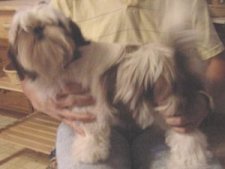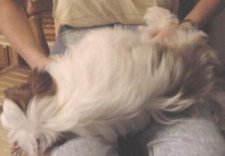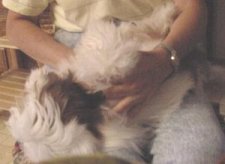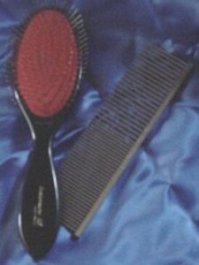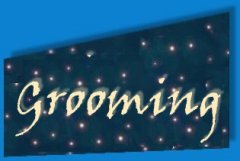
|
BASIC SHIH TZU GROOMING Puppy training A young Shih Tzu puppy really doesn't require a lot of grooming to keep it's hair free of tangles until it gets about 5 months or so old. It depends on the type of hair they have. Dogs with a thick cottony coat will require more grooming and at an earlier age than one with a thinner silkier coat. So does that mean you don't have to worry about grooming until the coat starts tangling? NO!. The puppy might not be matting right now but this is the best time to start teaching your puppy to be comfortable with being groomed. If you decide to keep the his hair shorter when he grows older he may not take a lot of regular brushing but this early training will make him much easier to handle when he is trimmed and for health checks too. He will learn to trust being touch and handled.
The grooming session will soon become a very enjoyable time for your dog as he learns it feels good to be brushed and it doesn't hurt at all. Once a dog learns to lie on its side, it will lay there comfortably as you gently work out what tangles you might find. Start out slow. The first lesson you should put him on your lap or if you prefer, sit on the floor with him and you will lay him on the floor by you. Some puppies will just kind of lie over if you scratch their stomachs. If your puppy will do that then great. Give the command " Over" as he lies over. But don't let him lay flat on his back. He needs to lay on his side. So you may want to roll him over to his side and rub his side and under his front legs. Talk calmly and assure him he is a good boy. Make him stay in that position for a minute or two. And then repeat the procedure on the other side.
Talk to the puppy and stroke it. Give him kisses if it helps. The main idea is to keep them in laying position for awhile. Usually they will slowly relax. Praise them greatly when they relax and wait just a short time and let the puppy up. When you feel them relax, you will know they are accepting what you are doing. Your puppy might not relax the first training session but should soon start accepting it. If he doesn't relax, still make him lay quietly for a few seconds. But don't make a wrestling match out of it. If the puppy is relaxing while laying over you can lay him over on both sides in each lesson. If he is still tense or struggling, only do one side per lesson and alternate sides. Once your puppy has learned to lay quietly on his side slowly teach him to allow you to lift each leg. Lay your puppy on his side and slowly rub your hand under his front leg. Gently lift his leg with the other hand and rub under the leg and his chest. Next rub your hand down to his stomach and on the inside of the rear leg, gently lifting the leg. Repeat the procedure on the other side. The purpose of this is for him to allow you to lift his legs to groom under the legs. Most dogs quickly accept this and will soon be ready to move on to the next step.
If you have to cut on a mat, take the scissors and cut from the skin out to end of the hair. In other words making a cut vertical to the skin that splits the tangle and makes it easier to work out with your hands. Horizontal cuts are again risky because you can cut the skin and they leave big holes in the coat that will take a very long time to grow out again. Ok now you have puppy comfortably lying on his side. You have your brush and comb handy and are ready to start brushing. The first few grooming sessions I usually do very little actual brushing. Just gently run the brush over the puppy's side and maybe the chest. Just to get them used to you having this "THING" in your hands and learn it isn't going to hurt. It might be a good idea to let him see the brush and investigate it before you lay him on his side. Maybe take the brush and brush down the hair on his back. Once he accepts the brushing you can start actual brushing. I usually brush the chest, under the front legs and stomach first. I work my way up to the part down the center of the back including the neck area and then go to the hind quarter and do the under the leg first and work my way up to the center back. Repeat the procedure on the other side. I usually brush out tail with the puppy lying on his stomach. Its also important to teach them to lie quietly on their stomach so you can groom the head and tail. Be very careful grooming around the eyes as not to injure an eye. I know the brushing sounds like a slow process but actually with a young puppy it goes very quickly because there is not that much hair which is good because your puppy wont have a very long attention span probably. You might have to take a rest and play break if he gets too restless. Usually by the time they get long enough hair to require extensive grooming they learn to be very patient. In a dog that has floor length coat it will take awhile to properly brush it out. At dog shows people always make the comment that they don't know how we train the dogs to lay so still and be patient. Well now you know how we do it. It is not all that difficult of a training procedure. I know here I have gone into great detail on how it's done but actually its very simple and is not that time consuming. On the beginning, a lot of it can be done just as part of your quiet playtime with puppy. Just take a few minutes to sit and hold the puppy and stoke him. Its something you would probably do anyway. And the best part is the puppy doesn't know he is learning something he just is enjoying the extra attention. This is the secret foundation to the whole grooming process. Make him think this is his own personal massage not a tortuous grooming session. You need to remain calm and don't fret if he doesn't get it right for awhile. He will learn but some dogs take longer than others. |
| [Home |Puppies|About us |Shows|Photos |Links] |
| © copyright 2000 Calypso Designs |
